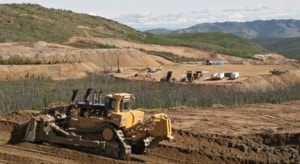Sherwood Copper Corp. has all the money it needs to get its Minto copper mine into production by April, 2007.
Company president and CEO Stephen Quin closed a deal with Australia’s Macquarie Bank Ltd. early Thursday, securing $85 million to finance the Yukon’s best bet — a viable medium-scale mining project.
“It’s pretty rare in the junior mining industry for a company that has no other producing assets and effectively no other assets to borrow $85 million against a project that hasn’t been built yet,” Quin said from Sherwood’s Vancouver offices on Thursday.
“The project is very strong, it’s very good grade.
“It’s a good margin for the bank. Even if metal prices go down, they realize there’s enough money to pay them back.”
Sherwood took over the Minto mine near Fort Selkirk and the North Klondike Highway in June 2005 and re-drilled the deposit to establish the value of the area that is expected to produce an average annual yield of more than 18 million kilograms of copper and more than 490 kilograms of gold.
The company completed a bankable feasibility study of the project in July 2006, several weeks after it began stripping the overburden to build an open-pit mine.
In August, Yukon Premier Dennis Fentie signed a memorandum of understanding with the Selkirk First Nation that addressed socioeconomic concerns.
Whitehorse contractor Pelly Construction Ltd. recently completed construction of a dam across Minto Creek, to create a reservoir for a yet-to-be-built processing plant.
“Thirty-five per cent of construction is complete for the entire project,” said Quin.
“We had to put a small dam in to hold water for processing; we had to prepare the site for the mill and concentrate shed.
“The bricks-and-mortar phase started about a month ago.”
Between 120 and 150 workers were employed at the mine over the summer, he said.
That number will drop to about 100 once the mine is in production, but those workers could be employed for the duration of the mine’s projected 7.2-year life and possibly beyond, if the adjacent hills hold the quality and quantity of copper and gold that Quin suspects.
“There are low hills to the south, essentially 200 metres from the pit that is planned, where we have a whole new area of mineralization that we have defined and we’ve put out a resource estimate,” he said.
Early next year a pre-feasibility study will explore the economics of bringing that material into production, he added.
But before any mining can begin at Minto, several things must happen over the next six months.
Only 40 per cent of the mine’s overburden has so far been removed, so that work will continue through the winter, said Quin.
Sherwood is in the process of hiring its senior management team for Minto, and Clark Builders out of Edmonton has yet to build the milling and processing facility.
“Essentially, during the summer, we focused on all the civil works that are either problematic or cannot be done during the winter … getting the foundations poured, getting the cement in place, getting the roads built, all that kind of thing,” said Quin.
“That’s all essentially complete or nearly complete.
“Now they’ll start throwing up the building very quickly.”
All of Minto’s permits and licences were grandfathered to Sherwood, so the project did not trigger an assessment from the Yukon Environmental and Socioeconomic Act.
“The project has been pretty well screened and pretty well understood,” said Quin.
“It’s a fairly benign project. Obviously mines always disturb, but there is no acid rock drainage; there is no heavy metals or anything like that associated with the project. There’s no cyanide being used.
“Overall, it has gone through its review process and any concerns raised have been addressed.”
With the remainder of the project’s $98-million budget now secured by a bank, Quin is optimistic.
The mine is already being powered by diesel generators, as the feasibility study presumed.
So while Sherwood agreed in a letter of intent with the Yukon Energy Corporation to purchase hydroelectric power if the Crown corporation decides to build a transmission line between two separate grids that currently end at Carmacks and Stewart Crossing, hydroelectricity is not required to make Minto fly.
The only real risk is missing deadlines because of a labour shortage, said Quin.
“We’re still on track to be ahead of schedule, as opposed to what the feasibility study said, which would be unusual in this type of environment.
“There are lots of projects, particularly with the oil sands. Most people are coming late and over-budget.
“We’re aiming to come in on budget and at least on schedule, if not ahead of schedule.
“The risk, as always with all construction projects, and even more so these days, is people, supplies, resources to get the job done on time.
“The risk is always that things take longer and cost more than they would have during less of a boom time for mining.”
